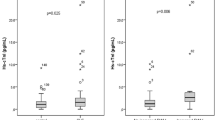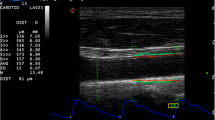Abstract
Systemic lupus erythematosus (SLE) is associated with premature atherothrombotic complications. Hyperhomocysteinemia is considered a cardiovascular risk factor. Increased vascular stiffness may increase cardiovascular mortality. Pulse wave velocity (PWV) is a noninvasive method of analyzing vascular stiffness in the assessment of atherosclerosis. The objective of this study was to identify the relationship between plasma homocysteine levels and brachial–ankle pulse wave velocity (baPWV) measurement in SLE. Plasma homocysteine, baPWV, ankle–brachial index, blood pressure, C3, C4, anticardiolipin antibody (aCL), and anti-double-stranded DNA antibodies were determined in a total of 58 female patients with SLE. The control group comprised 32 age-matched healthy females. In addition, all patients were further classified into subgroups according to the presence of aCL (SLE/aCL+, n=27 vs SLE/aCL−, n=31) to determine the effect of aCL on the tested variables. The mean values for plasma homocysteine and baPWV were 13.19 μmol/l and 1,482 cm/s, respectively. Plasma homocysteine levels were significantly elevated in SLE patients when compared with the healthy controls. SLE patients with aCL had a significantly higher plasma homocysteine level than those without aCL. A significant positive correlation between plasma homocysteine and baPWV was found in patients with SLE (r=0.335, P=0.028, n=58). Plasma homocysteine also significantly correlated with right baPWV in all SLE patients (r=0.371, P=0.014, n=58) and in the SLE/aCL+ group (r=0.523, P=0.031, n=27). These findings indicate a possible link between plasma homocysteine and baPWV in SLE. In conclusion, SLE patients had an increased level of plasma homocysteine, and this phenomenon appeared to be related to vascular stiffness.
Similar content being viewed by others
References
Steinberg AD, Klinman DM (1988) Pathogenesis of systemic lupus erythematosus. Rheum Dis Clin North Am 14:25–41
Abu-Shakra M, Urowitz MB, Gladman DD, Gough J (1995) Mortality studies in systemic lupus erythematosus: results from a single center. I. Causes of death. J Rheumatol 22:1259–1264
Ward MM (1999) Premature morbidity from cardiovascular and cerebrovascular diseases in women with systemic lupus erythematosus. Arthritis Rheum 42:338–346
Stein JH, McBride PE (1998) Hyperhomocysteinemia and atherosclerotic vascular disease: pathophysiology, screening and treatment. Arch Intern Med 158:1301–1306
Hultberg B, Andersson A, Sterner G (1993) Plasma homocysteine in renal failure. Clin Nephrol 40:230–234
Haagsma CJ, Blom HJ, Piet LCM et al (1999) Influence of sulphasalazine, methotrexate, and the combination of both on plasma homocysteine concentrations in patients with rheumatoid arthritis. Ann Rheum Dis 58:79–84
Refai TMK, Al-Salem IH, Nkansa-Dwamena D, Al-Salem MH (2002) Hyperhomocysteinaemia and risk of thrombosis in systemic lupus erythematosus patients. Clin Rheumatol 21:457–461
Petri M, Roubenoff R, Dallal GE et al (1996) Plasma homocysteine as a risk factor for atherothrombotic events in systemic lupus erythematosus. Lancet 348:1120–1124
Fijnheer R, Roest M, Haas FJ et al (1998) Homocysteine, methylenetetrahydrofolate reductase polymorphism, antiphospholipid antibodies, and thromboembolic events in systemic lupus erythematosus: a retrospective cohort study. J Rheumatol 25:1737–1742
Laurent S, Boutouyrie P, Asmar R et al (2001) Aortic stiffness is an independent predictor of all-cause and cardiovascular mortality in hypertensive patients. Hypertension 37:1236–1241
Meaume S, Benetos A, Henry OF, Rudnichi A, Safar ME (2001) Aortic pulse wave velocity predicts cardiovascular mortality in subjects >70 years of age. Arterioscler Thromb Vasc Biol 21:2046–2050
Shoji T, Emoto M, Shinohara K et al (2001) Diabetes mellitus, aortic stiffness, and cardiovascular mortality in end-stage renal disease. J Am Soc Nephrol 12:2117–2124
van Popele NM, Grobbee DE, Bots ML et al (2001) Association between arterial stiffness and atherosclerosis: the Rotterdam study. Stroke 32:454–460
Yamashina A, Tomiyama H, Takeda K et al (2002) Validity, reproducibility, and clinical significance of noninvasive brachial–ankle pulse wave velocity measurement. Hypertens Res 25:359–364
Aso K, Miyata M, Kubo T et al (2003) Brachial–ankle pulse wave velocity is useful for evaluation of complications in type 2 diabetic patients. Hypertens Res 26:807–813
Yokoyama H, Hirasawa K, Aoki T, Ishiyama M, Koyama K (2003) Brachial-ankle pulse wave velocity measured automatically by oscillometric method is elevated in diabetic patients with incipient nephropathy. Diabet Med 20:942–945
Choi KM, Lee KW, Seo JA et al (2004) Relationship between brachial–ankle pulse wave velocity and cardiovascular risk factors of the metabolic syndrome. Diabetes Res Clin Pract 66:57–61
Ohnishi H, Saitoh S, Takagi S et al (2003) Pulse wave velocity as an indicator of atherosclerosis in impaired fasting glucose: the tanno and sobetsu study. Diabetes Care 26:437–440
Munakata M, Ito N, Nunokawa T, Yoshinaga K (2003) Utility of automated brachial ankle pulse wave velocity measurements in hypertensive patients. Am J Hypertens 16:653–657
Yamashina A, Tomiyama H, Arai T et al (2003) Brachial–ankle pulse wave velocity as a marker of atherosclerotic vascular damage and cardiovascular risk. Hypertens Res 26:615–622
Imanishi R, Seto S, Toda G et al (2004) High brachial–ankle pulse wave velocity is an independent predictor of the presence of coronary artery disease in men. Hypertens Res 27:71–78
Refsum H, Ueland PM, Nygard O, Vollset SE (1998) Homocysteine and cardiovascular disease. Annu Rev Med 49:31–62
Eikelboom JW, Lonn E, Genest J Jr, Hankey G, Yusuf S (1999) Homocysteine and cardiovascular disease: a critical review of the epidemiologic evidence. Ann Intern Med 131:363–375
Hsu TS, Hsu LA, Chang CJ et al (2001) Importance of hyperhomocysteinemia as a risk factor for venous thromboembolism in a Taiwanese population. A case-control study. Thromb Res 102:387–395
Welch GN, Loscalzo JN (1998) Homocysteine and atherothrombosis. N Engl J Med 338:1042–1050
Martinez-Berriotxoa A, Ruiz-Irastorza G, Egurbide MV, Rueda M, Aguirre C (2004) Homocysteine, antiphospholipid antibodies and risk of thrombosis in patients with systemic lupus erythematosus. Lupus 13:927–933
Martinez-Berriotxoa A, Ruiz-Irastorza G, Egurbide MV, Rueda M, Aguirre C (2003) Plasma homocysteine levels in patients with systemic lupus erythematosus. Med Clin (Barc) 120:681–685
Tan EM, Cohen AS, Fries JF et al (1982) The 1982 revised criteria for the classification of systemic lupus erythematosus. Arthritis Rheum 25:1271–1277
Friedewald WT, Levy RI, Fredrickson DS (1972) Estimation of the concentration of low-density lipoprotein cholesterol in plasma without use of the preparative ultracentrifuge. Clin Chem 18:499–502
Expert panel on detection, evaluation, and treatment of high blood cholesterol in adults (2001) Executive summary of the third report of the National Cholesterol Education Program (NCEP) expert panel on detection, evaluation, and treatment of high blood cholesterol in adults, adult treatment panel III. JAMA 285:2486–2497
National Cholesterol Education Program (NCEP) Expert Panel on detection, evaluation, and treatment of high blood cholesterol in adults (Adult treatment panel III) (2002) Third report of the National Cholesterol Education Program (NCEP) expert panel on detection, evaluation, and treatment of high blood cholesterol in adults (adult treatment panel III) final report. Circulation 106:3143–3421
Bombardier C, Gladman DD, Urowitz MB et al (1992) Derivation of the SLEDAI: a disease activity index for lupus patients. Arthritis Rheum 35:630–640
Chang DM, Lan JL, Lin HY, Luo SF (2002) Dehydroepiandrosterone treatment of women with mild-to-moderate systemic lupus erythematosus. Arthritis Rheum 46:2924–2927
Tso TK, Huang HY, Chang CK, Liao YJ, Huang WN (2004) Clinical evaluation of insulin resistance and β-cell function by the homeostasis model assessment in patients with systemic lupus erythematosus. Clin Rheumatol 23:416–420
Hayashi C, Ogawa O, Kubo S, Mitsuhashi N, Onuma T, Kawamori R (2004) Ankle brachial pressure index and carotid intima-media thickness as atherosclerosis markers in Japanese diabetics. Diabetes Res Clin Pract 66:269–275
Clarke R, Daly L, Robinson K et al (1991) Hyperhomocysteinemia: an independent risk factor for vascular disease. N Engl J Med 324:1149–1155
Ueland PM, Refsum H, Beresford SAA, Vollset SE (2000) The controversy over homocysteine and cardiovascular risk. Am J Clin Nutr 72:324–332
Welch GN, Loscalzo JN (1998) Homocysteine and atherothrombosis. N Engl J Med 338:1042–1050
Boushey CJ, Beresford SAA, Omenn GS, Motulsky AG (1995) A quantitative assessment of plasma homocysteine as a risk factor for vascular disease, probable benefits of increasing folic acid intakes. J Am Med Assoc 274:1049–1057
den Heijer M, Koster T, Blom HJ et al (1996) Hyperhomocysteinemia as a risk factor for deep-vein thrombosis. N Engl J Med 334:759–762
Selzer F, Sutton-Tyrrell K, Fitzgerald S, Tracy R, Kuller L, Manzi S (2001) Vascular stiffness in women with systemic lupus erythematosus. Hypertension 37:1075–1082
Hossain GS, van Thienen JV, Werstuck GH et al (2003) TDAG51 is induced by homocysteine, promotes detachment-mediated programmed cell death, and contributes to the development of atherosclerosis in hyperhomocysteinemia. J Biol Chem 278:30317–30327
Buemi M, Marino D, Di Pasquale G et al (2001) Effects of homocysteine on proliferation, necrosis and apoptosis of vascular smooth muscle cells in culture and influence of folic acid. Thromb Res 104:207–213
Acknowledgements
This research was supported by a research grant from Taichung Veterans General Hospital (TCVGH-913801A). The authors thank Ms. Ying-Ju Liao for her technical assistance in biochemical analyses.
Author information
Authors and Affiliations
Corresponding author
Rights and permissions
About this article
Cite this article
Tso, T.K., Huang, HY., Chang, CK. et al. A positive correlation between homocysteine and brachial–ankle pulse wave velocity in patients with systemic lupus erythematosus. Clin Rheumatol 25, 285–290 (2006). https://doi.org/10.1007/s10067-005-0063-7
Received:
Accepted:
Published:
Issue Date:
DOI: https://doi.org/10.1007/s10067-005-0063-7




